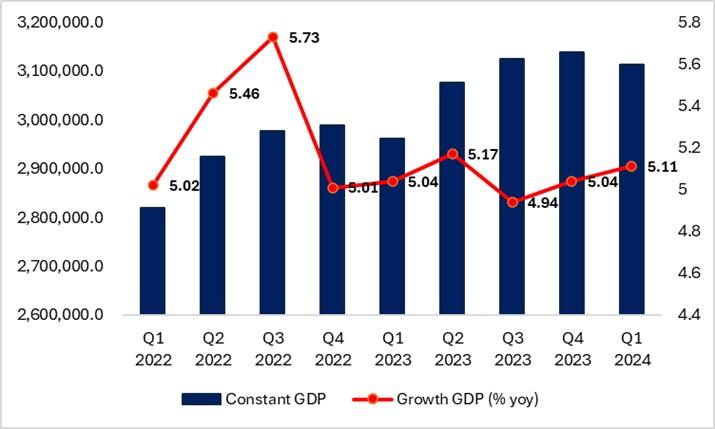Indonesia’s Economic Landscape: Challenges and Strategic Responses
Indonesia is currently facing a significant economic deceleration, influenced by the dual pressures of escalating US tariffs and mounting fiscal challenges. These factors present substantial hurdles for President Prabowo Subianto’s economic aspirations. As the country maneuvers through a complicated global trade environment while dealing with internal financial strains, experts are keenly observing the potential impacts on Indonesia’s growth trajectory and overall stability. This slowdown not only jeopardizes Prabowo’s vision for dynamic economic progress but also raises essential questions regarding Indonesia’s capacity to withstand external shocks and maintain its momentum in an ever-evolving global economy. In this analysis, we will explore the underlying factors contributing to this situation and their possible long-term effects on Southeast Asia’s largest economy.
Effects of US Tariffs on Indonesian Exports and Trade Dynamics
The recent surge in tariffs from the United States has dramatically reshaped conditions for Indonesian exporters. The introduction of these trade barriers has constrained export growth significantly, particularly affecting vital sectors such as textiles, electronics, and agriculture. The consequences of these tariffs can be summarized through several key points:
- Decreased Market Competitiveness: Elevated tariffs have diminished the competitiveness of Indonesian products in the US market, resulting in reduced demand.
- Higher Production Expenses: Exporters are facing increased costs due to tariffs on imported materials, which leads to higher prices that deter American consumers.
- Disruption of Supply Chains: Tariff impositions have caused interruptions within supply chains, compelling exporters to reevaluate their strategies or seek alternative markets.
In light of these obstacles, Indonesia is actively seeking various approaches to alleviate the negative impacts stemming from US tariffs while enhancing its trade relationships globally. Engaging in regional trade agreements alongside diversifying export markets are crucial strategies moving forward. Below is a summary of potential initiatives:
| Tactic | Description |
|---|---|
| Regional Trade Partnerships | Cultivating stronger connections with ASEAN nations and other regional economies as a counterbalance to diminished trade with the U.S. |
| Diversification of Products | Pursuing development opportunities for new products that can find success across varied international markets. |
Overcoming Fiscal Challenges: Strategies for Prabowo’s Economic Vision
The Indonesian government must implement innovative strategies amid rising U.S. tariffs coupled with domestic fiscal pressures if it hopes to stimulate growth effectively while ensuring stability under Prabowo’s leadership. A critical component involves optimizing tax frameworks aimed at boosting revenue without hindering business expansion efforts. By diversifying income sources through creative taxation models, traditional sectors may experience relief while simultaneously nurturing digital commerce growth.
Tackling bureaucratic inefficiencies will also be essential for attracting foreign investments necessary for infrastructure enhancement and job creation initiatives.
Furthermore, enhancing export strategies by focusing on strengthening ties with non-U.S.-based markets can help mitigate tariff repercussions effectively; pursuing agreements with emerging economies throughout Asia could open up new consumer bases.
Investing in research & development (R&D) within local industries—especially agriculture and technology—will enhance global competitiveness.
Additionally,, leveraging financial resources towards large-scale projects will ensure that fiscal limitations do not obstruct developmental objectives.
Strategic Recommendations for Sustaining Indonesia’s Economic Growth
Navigating today’s intricate economic landscape requires Indonesia to adopt a comprehensive strategy aimed at bolstering resilience while promoting sustainable advancement.
Key recommendations include:
- Diversifying Trade Partnerships: Expanding collaborations beyond conventional trading partners can lessen reliance on U.S.-based exports; fostering agreements with emerging economies may unveil fresh avenues for expansion.
- Amping Up Domestic Production Capabilities: Investments directed toward local industries—particularly technology-driven sectors—will decrease import dependency whilst stimulating job creation thereby enhancing domestic consumption levels.
- Tightening Fiscal Policies: Implementing sound fiscal measures focused on long-term sustainability will address current challenges whilst keeping foreign investment appealing.
The government should also embrace innovation across various sectors by creating an environment conducive to startups along with integrating advanced technologies into traditional industries which would boost productivity levels significantly.
Additional strategic actions might encompass:
- < li >< strong >Enhancing Infrastructure Development:< / strong > Continued investment into transportation networks alongside digital infrastructure remains vital towards facilitating seamless trade operations ensuring market accessibility< / li >< li >< strong >Advocating Education & Skills Training:< / strong > Tailoring educational programs aligned closely around modern industry demands prepares future workforces adequately addressing upcoming challenges & opportunities< / li > ul > p >
Conclusion
The current state of Indonesia’s economy presents an intricate blend of challenges as it contends against global shifts like rising U.S.-imposed tariffs coupled alongside internal fiscal constraints impacting Minister Prabowo Subianto’s administration heavily . As stakeholders navigate these adversities ahead , innovative policy responses combined strategically resilient approaches become paramount . Collaborative efforts among all parties involved must focus diligently upon steering clear amidst turbulent waters ensuring aspirations geared towards sustainable progress remain attainable . With key indicators reflecting slowing momentum , forthcoming months stand pivotal determining how well positioned Indonesia adapts refocuses its broader economic agenda against increasingly uncertain international backdrops . Thus , testing resilience becomes crucial shaping future trajectories upon world stages ahead .
